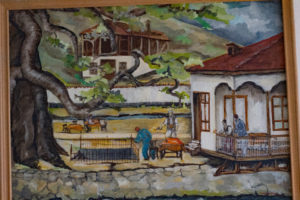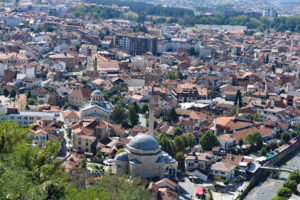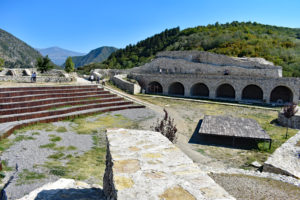Kosovo is only a small country and for our five-day trip, “Regent Holidays”:https://www.regent-holidays.co.uk/?infinity=ict2~net~gaw~ar~393963111525~kw~regent%20holidays~mt~e~cmp~BRAND~ag~Regent%20Holidays%20-%20Exact&gclid=EAIaIQobChMI_IvQmK2z6AIVVuDtCh0-PgPuEAAYAiAAEgL0aPD_BwE suggested basing ourselves in Prizren, where we stayed at the “Hotel Kaçinari”:https://www.silvertraveladvisor.com/review/accommodation/203061-review-hotel-ka-inari, rather than the capital Prishtina.
On arrival, we had an afternoon city tour with a young and rather energetic guide, Veron. It’s a compact city and ideal for walking and at the end of the 3 hours, I’d walked nearly 12,000 steps.
The River Bistrica, or Lumbardhi as it’s known in Serbian, dissects the city. The 40 Bunar Fest, regarded as Kosovo’s craziest race, takes place annually in May when people float down the river in tractor tyre inner tubes, despite low water levels, protruding rocks and freezing water. And in August, the annual film festival, DukoFest, is held when people sit on the dried riverbed.
There are two foot bridges over the river. The first, directly opposite our hotel, was Lanet’s Bridge. It was previously wooden and known as the cursed bridge and so was seldom used. However, now it’s covered in padlocks symbolising love, there are concerns about the weight of them. The other, the Stone Bridge, was destroyed by swirling storm waters in 1979 and painstakingly renovated three years later stone by stone.
We visited the cobbled Shadërvan, or fountain square. Here, lots of people were washing their hands and filling up water bottles as there’s a saying ‘he who drinks water from the Shadërvan fountain will find it hard to leave Prizren’. With bars and restaurants on all sides, many with outdoor terraces, it’s naturally a popular meeting spot.
Veron told us there were 42 mosques in the city’s historical centre and 100 in the city, which is divided into three parts: the historical centre, the old part and new part.
Across from the Stone Bridge was the Sinan Pasha or Stone Mosque, as its more commonly known. Whilst not the largest mosque, its dome is and the whole building is covered by lots of windows, said to be very unusual. Inside were frescoes on the ceilings and walls. A Star of David has been embedded into one of the windows and the minaret, although no one knows why. There are so many worshippers at Friday prayers, they line the pavement with sheets so everyone can join in, even if the mosque is full.
Nearby was the minaret of the Arata Mosque, the only part saved when the area was turned into a shopping centre in the 1960s. Veron said it had taken him an hour to climb to the top due to the narrowness and number of steps: we decided against it.
Next, we pressed on to the Serbian Orthodox Church, Our Lady of Lejevi. Unfortunately it was closed, had police protection and barbed wire on the top. It began life in the 14th century as a church, then a mosque before being restored to a church with the minaret and white plaster being removed. The interior frescoes had been damaged by the Ottomans who had dug out small circles in the plaster. The windows had been bricked up and we thought it must have been very dark inside.
At the time of our visit, in September, the Autostrada Biennale, with its 32 city wide art installations, was in its last few weeks. A focus was housed in the Archaeology Museum. This was previously a hamman and there were arched doorways, lights in the circular domes and small rooms to wander round showcasing coins, buckles and jewellery found locally from the various ages. The art was contemporary and a good mix with the old building. Amongst the exhibits was a wall containing 49 faces of modern leaders with one being taken down each day and put in a nearby paddling pool of water. The blank spaces were revealing the statement ‘kill all lies’. Another display case contained two gold turtles and an apple: one looking in anticipation at eating the fruit and then the other being disappointed having bitten it. We completed our visit by walking up the 100 wooden steps to the top of the clock tower for superb views through the windows which had to be opened in a set sequence as the space was small.
Moving on we came to The League of Prizren buildings. This was an Albanian political organisation, established in 1878 in the old town of Prizren. The museum complex comprised of whitewashed two storey buildings around a central area with gardens. The first, had small rooms on the ground floor with kitchen utensils and ethnic Albanian and Kosovo costumes. A Kosovan thick wool jacket with a hood in dark brown and weighing 25lb would have been worn by a bride on her wedding night. Upstairs were pictures, portraits and statutes of people who played an important role, including what was said to be the most valuable painting of an Ottoman spy being shot beside the Marash Tree, a famous old tree with a 2m wide trunk which we later visited. The second building had been reconstructed after being burnt down by Serbian forces in 1999. It held copies of many official documents, transcribed into English.
During our tour of the city, we passed numerous other buildings both old and new which included:
The white-washed Turkish embassy with its central location denoting the importance of Turks in the country.
The remnants of the river facing old bazaar, knocked down in the 1980s to create a modern shopping complex.
Gazi Memet Pasha Hamman, currently being restored by UNESCO, although work had stopped as they were putting lead on the stone which was incorrect.
The first three storey building in Prizren, art deco in style with a balcony and two doors as it would have been inhabited by two families.
Horseshoe street full of ironmongers selling knives and horn products.
On another day, we visited the Castle under our own steam. It was an incredibly steep path up and having passed the Serbian Orthodox Church of Hrista Spasitelja we kept on for going for 30 minutes with frequent huffing and puffing stops. Entrance was free as a huge amount of restoration was ongoing, and having walked under an arch, where drinks and ice-creams were for sale, we explored the grounds. The views were spectacular, and we spotted many of the sights we’d seen on our tour with Veron. As part of the Biennale, a series of five videos were being played in the darkness of the original arches. However, I found them slightly bizarre. In one, someone was pointing out circle shapes which involved lovingly caressing the shape of a road sign, circular pipes and two guys eating and drinking whilst another filmed a child gazing out of a window at a doll that was behaving like a helicopter. Meanwhile Roy explored the fortress and found an amphitheatre, surrounded by both seats and bricked alcoves, and in the far corner, a secret passage down to ground level. This was apparently an escape option and also part of a network of tunnels. Our way back was down the steep path, we then continued onward to the Cathedral of our Lady of Perpetual Succour, although this was under scaffolding and not open to visitors.
Regent’s advice was good, but having visited “Pristina”:https://www.silvertraveladvisor.com/review/attraction/203318-review-sightseeing-in-pristina on a day trip, we could have stayed there for a night or two. Prizren certainly lived up to its reputation as the jewel in Kosovo’s crown.










